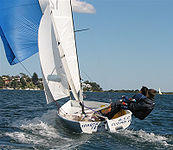Flying Eleven (dinghy)
| 50x40px | This article may need to be rewritten entirely to comply with Wikipedia's quality standards. You can help. The discussion page may contain suggestions. (May 2009) |
| 40px | This article's introduction may be too long. Please help by moving some material from it into the body of the article. Read the layout guide and Wikipedia's lead section guidelines for more information. Discuss this issue on the talk page. (October 2009) |
| Current Specifications | |
|---|---|
 | |
| Crew | 2 |
| Beam | 1.33 m (4 ft 4 in) |
| Hull weight | 3.3 m (11 ft) |
| Mainsail area | 6.04 m2 (65.0 sq ft) |
| Jib / Genoa area | 2.51 m2 (27.0 sq ft) |
| Spinnaker area | 4.46 m2 (48.0 sq ft) |
The Flying Eleven is an Australian boat designed as a high performance racing skiff suitable for 12 to 18 year olds. High performance sailing is fast becoming the goal of a great many dinghy sailors with the appearance of 49ers as an Olympic class.[citation needed] The Flying Eleven is a logical step in the transition between junior classes such as the Manly Junior or Sabot and prepares young sailors for classes such as Cherubs, 420s, 470s, 29ers, Moths, 13s or even 49ers.
95 boats competed on Sydney Harbour at the 2005 National Championship, while 72 went to Belmont 16' Skiff Sailing Club for the 2006 Championship. 43 went to the Nedlands Yacht Club in Perth for the 2007 Nationals.
History
The F11 started in 1964. The main classes available for training young sailors were the VJ, MJ, Moth, Heron and it appeared there was an opening for a class with:
- Comparative speed to the VJ
- No hiking boards
- More leg room
- Main, jib and spinnaker
- Light weight for transporting
- A crew of two
- Ease of building and
- The possibility of dad getting his foot in occasionally
The acceptance campaign then started and three different "models" of the Flying Eleven were taken to different clubs each weekend and sailed in all weathers. These three models were called the Open Sailer, the Self Drainer, and the Fully Decked Model. The fully decked model did not appeal to the go-fast boys and, although the self drainer was popular, the VJ self drainer was well established therefore the emphasis was put on a boat which, firstly, had to be expertly sailed to stay afloat and, secondly, would serve as a trainer for the open skiff classes — so the open sailer it had to be.
During the 1965–66 season Sans Souci Club accepted the F11 as a class, other clubs slowly followed and the NSW Fll Association was formed in 1967. After trying various types of additional buoyancy, such as side tanks, the lines were redrawn and a complete set of plans issued to the Association, covering hull, sails, centreboard and rudder.
The early F11s were not as attractive or sophisticated as today - the clew of the genoa was 16" above the gunwale — the mainsail hung from one full length top batten, with some short leech battens, all battens were made of cane, and the venturis, which were tube and box type with corks, would today be regarded as museum pieces.
High profile sailors to come from the class:
- In recent years: Jacqui Bonnitcha, Joe Turner, James Dorron, John Winning, Kylie Mara, Nathan Outteridge, Nicky Souter.
- Over the years: Adam Beashel, Craig Ferris, James Spithill, Jonathan Bonnitcha, Malcolm Page, Michael Coxon, Nathan Wilmot, Stephen McConaghy .
Names of clubs & locations
- Abbotsford 12’Skiff Sailing Club;
- Avalon Sailing Club;
- Bayview Yacht Racing Association;
- Belmont 16’ Skiff Club;Canberra Yacht Club;
- Clarence River Sailing Club;
- Coffs Harbour Yacht Club;
- Connells Point Sailing Club;
- Cronulla Sailing Club;
- Derwent Sailing Squadron (TAS);
- Dobroyd Aquatic Club;
- Drummoyne Sailing Club;
- Gosford Sailing Club;
- Greenwich Sailing Club;
- Hornsby PCYC Sailing Club;
- Hunters Hill Sailing Club;
- Keppel Bay Sailing Club;
- Lake Cootharaba Sailing Club;
- Lane Cove 12’Skiff Sailing Club;
- Lindisfarne Sailing Club;
- Manly 16’ Skiff Sailing Club;
- Manning River Sailing Club;
- Nedlands Yacht Club (WA);
- Port Hacking Open Sailing Club;
- Richmond River Sailing Club;
- Royal Motor Yacht Club (Pittwater);
- Royal Queensland Yacht Squadron (QLD);
- Royal Prince Alfred Yacht Club;
- Royal Yacht Club of Tasmania (TAS);
- Saratoga Sailing Club;
- Tamar Yacht Club (TAS);
- Teralba Amateur Sailing Club;
- Vaucluse Sailing Club;
- Woollahra Sailing Club -->
External links
- Pages with broken file links
- Wikipedia articles needing rewrite from May 2009
- Articles with invalid date parameter in template
- Articles needing cleanup from October 2009
- All pages needing cleanup
- Wikipedia introduction cleanup from October 2009
- Pages with intro too long
- All articles with unsourced statements
- Articles with unsourced statements from January 2008
- Dinghies
